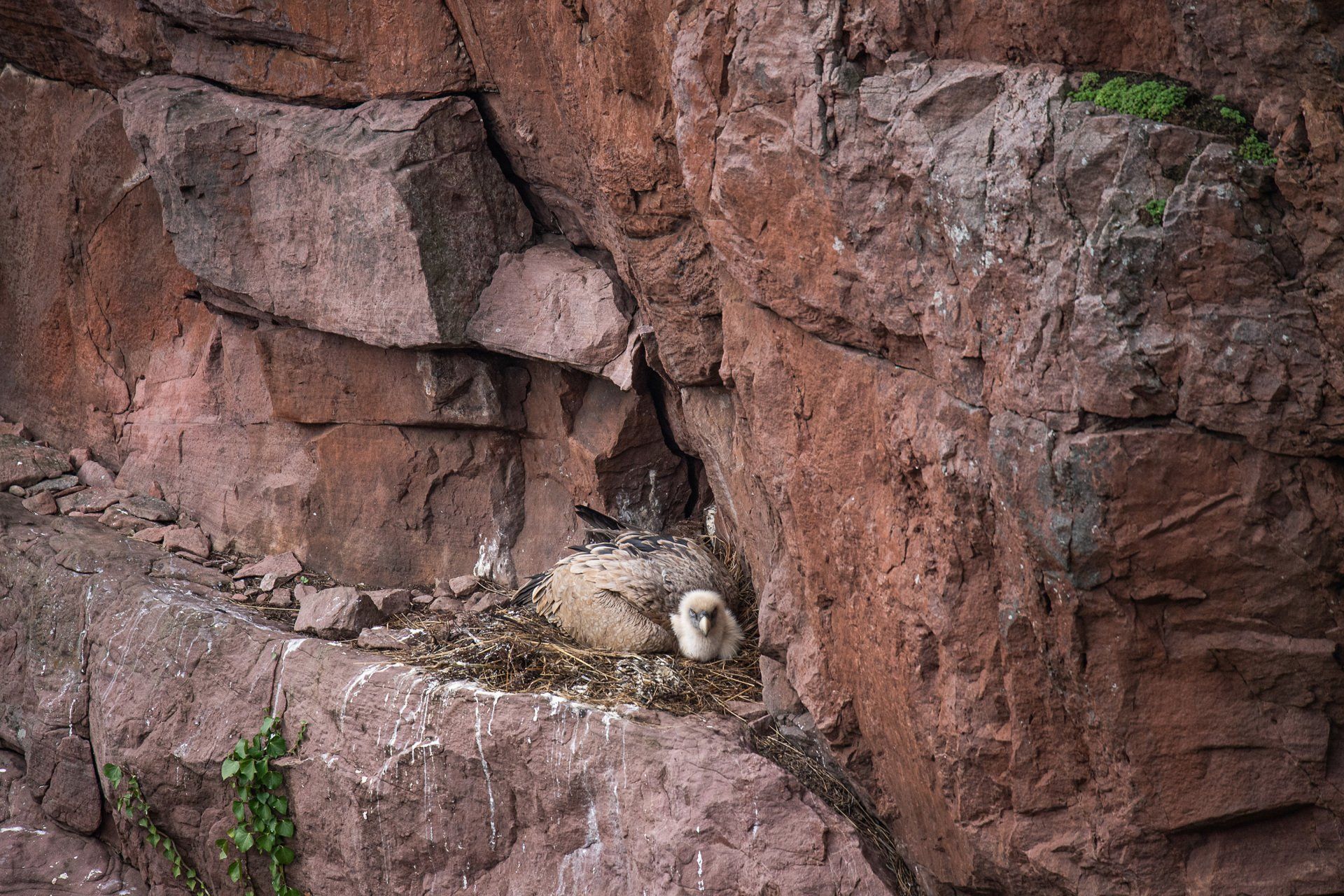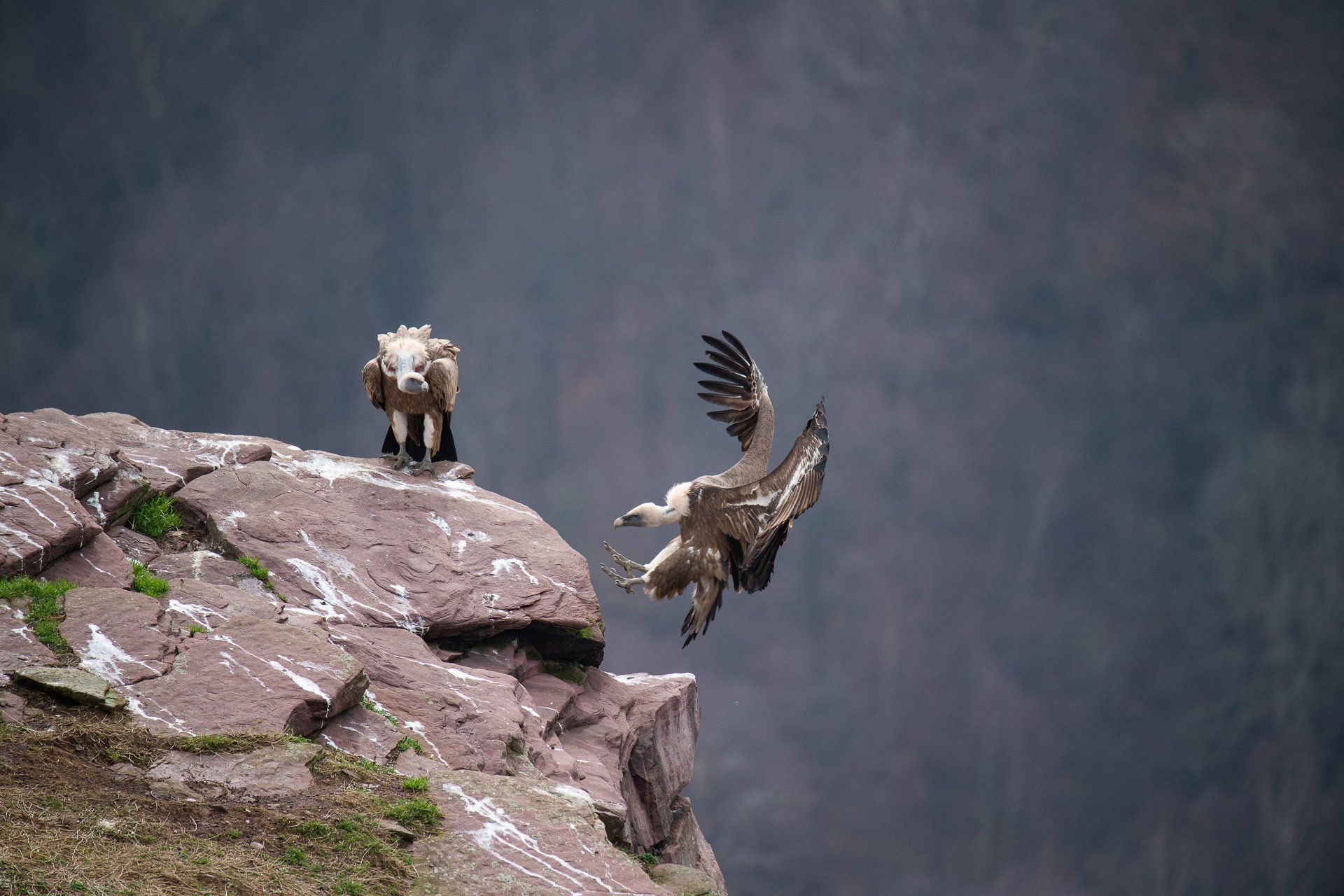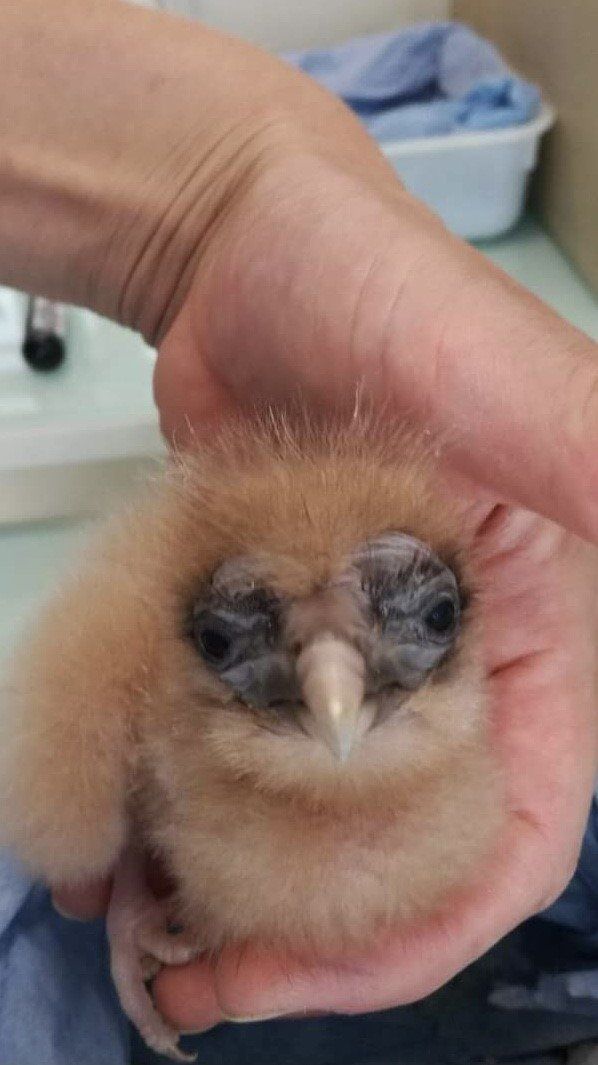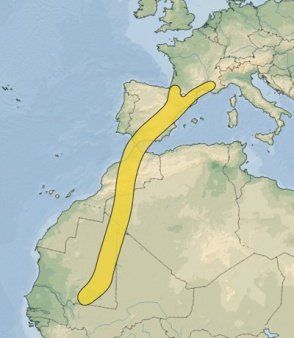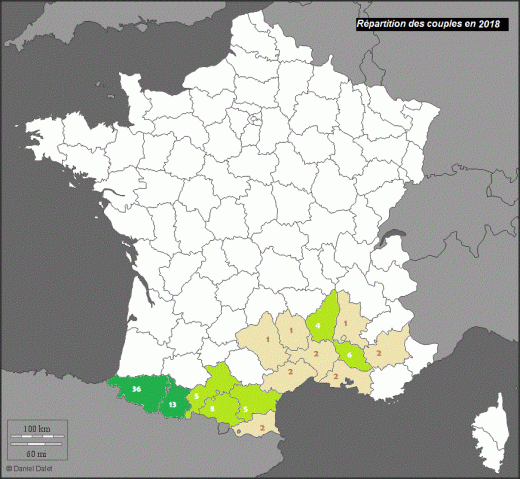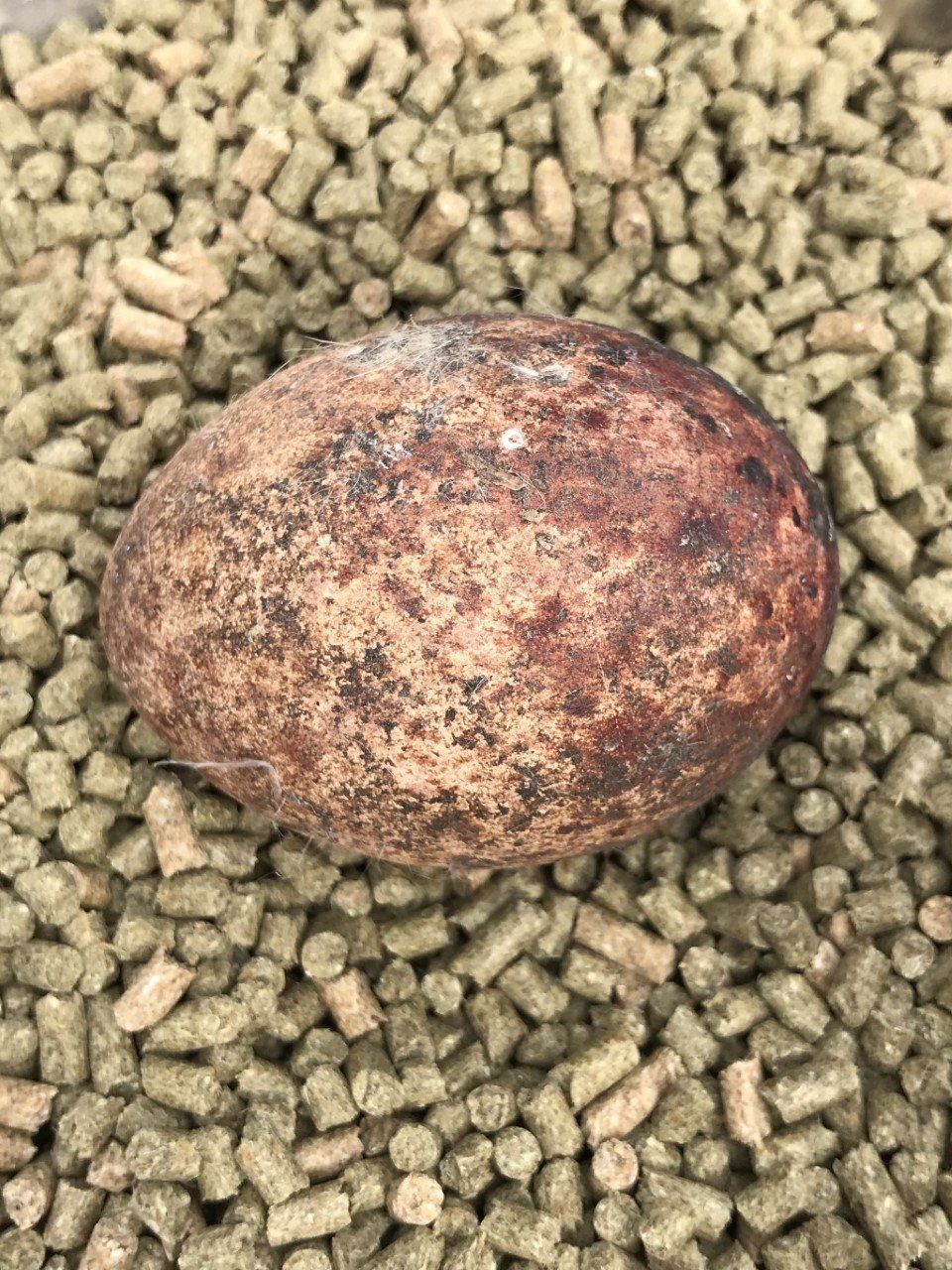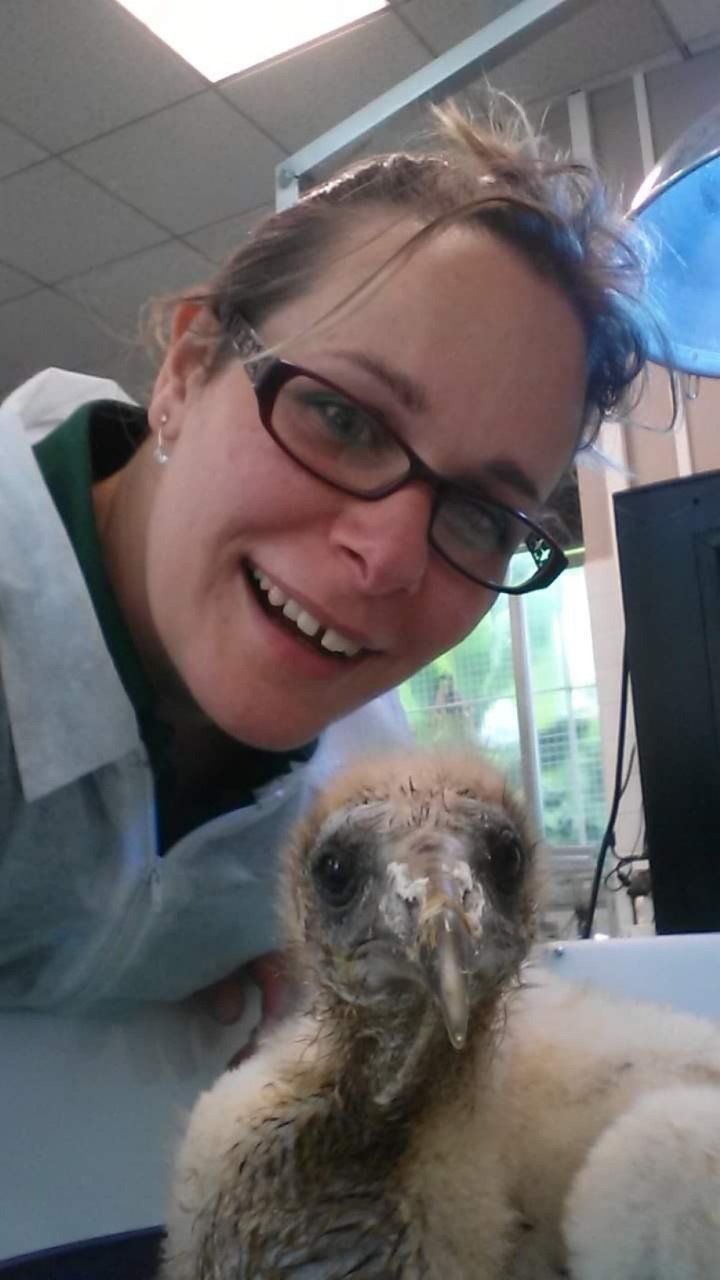Griffon and Egyptian Vultures in the Country Bascus.
These threatened air giants.
Generality
Conservation status
Anatomy
Vultures are built to fly and equipped to take down carcasses. Their peculiar diet, which would kill any animal, is digested with powerful gastric juices which neutralize bacteria. Their perfect anatomy serves this mountain knacker.
The wings/feathers
The chicks are born with a down quickly replaced by their first feathers. The remiges, these feathers that allow them to soar. The wings of the griffon vulture have, for example, 10 secondary remiges and 6 "fingered" primaries, called fingered, giving it a wingspan of up to 2.80 m. Moulting (renewal of feathers) occurs during the summer. Their wings are wide and long in order to have better lift for gliding, so they don't have to wear themselves out flapping their wings. The heads of most species, such as the griffon vulture, have no feathers on their necks, but only down, so as not to soil their plumage when they devour the carcasses. The Egyptian vulture has a bare face because it comes last in the food chain and does not have to dig into the carcass. Full adult plumage occurs around 5 years of age.
Photos (A. Magnier/ MNHN/ JC Rivas):
Young Egyptian Vulture in different stages of growth.
Large wingspan with digitate flight feathers and down-covered neck for the griffon vulture.
Beak
Vultures have sharp beaks. Its usefulness is to cut the leather or the muscles of the carcasses so that the animal can eat as quickly as possible. Species have different beak shapes depending on their position in the food chain. The griffon vulture often intervenes first, so it has a wide curved beak, while the Egyptian vulture, which intervenes last, has a thin beak to scour the remains of the carcass. Each species therefore has an ecological role in the food chain. Thanks to their beaks, a carcass is reduced to a skeleton in a few hours. Beak color also changes with age.
Photos: JC Rivas/ S. Goutenègre MNHN/ E. Baril
The paws
The legs of vultures are not prehensile, they do not allow them to transport prey, unlike nournal raptors which hunt with their sharp claws. They have 4 sharpened fingers with slightly curved talons allowing it to move by walking or hopping. The Egyptian vulture is a great walker, it likes to wander in fields, mass graves or waste dumps in search of food. During the quarry, it intervenes after the passage of the other vultures, sneaking among its larger congeners. In flight, the legs of birds are curved along the body and almost invisible, except during the landing phase.
Photos (S. Goutenègre MNHN/ JC. Rivas): Long slender fingers of the Egyptian vulture. Griffon Vulture in landing mode.
The eyes
The general public often thinks that scavengers are on the lookout for carcasses by smell. This is false, they have almost no sense of smell. On the other hand, they have a piercing and exceptional sight! They can see 8 times better than us! A bird is able to see an object of 30 cm at 300 m in height. In flight, birds observe each other a lot. It is by spotting their congeners that they take updrafts or swoop down on a carcass. With age, eye color changes.
Photos: JC. Rivas/ S. Goutenègre MNHN
The digestive system
Vultures are scavengers whose diet would kill any other species. For good reason, they have a concrete stomach with a very acidic PH1!
The powerful gastric juices of the vultures overcome the most deadly bacteria. Its microbiota (intestinal flora) is made up of Clostridium Where Fusobacterium.
While the human stomach can contain nearly 1,000 types of bacteria, the vulture's has ten times fewer.
The food is partially digested in the crop. However, when the vulture eats on a carcass, it ingests large quantities (up to 1 kg of meat) in record time (less than 1h30). If he is disturbed, in order to make himself lighter to take off, he can then regurgitate his food... which he had nevertheless patiently watched for.
The droppings appear almost 5h30 after the cleaning. To sum up, by feeding on carrion, vultures break the chain of microbial and parasitic contamination.
Pictures : Jean-Charles Rivas
Plan: Edition Hatier
A colony life!
Vultures have the particularity, for certain species such as the griffon vulture, of living in more or less large colonies. Each couple has its place there, with its own nest for each season. Since 2019, we have been following a colony in the Basque country to list births there.
The effectiveness of the number...
It is well known, the number makes the difference. For griffon vultures, for example, it's just as true for finding food! Vultures do not hunt strictly speaking, but explore their territory in search of a carcass. They use the updrafts in a column of about 50 individuals to soar long distances, without a wing beat, in order to save themselves. After gaining altitude, the colony deploys remaining in visual contact with each other. We remind you that vultures have a piercing sight, 8 times better than ours! As soon as one of the members spots a carcass, he goes down on it to report it to the others. Thus, everyone is guaranteed to eat. It takes between 500 gr to 1 kg of meat per day for a vulture to be satiated. He may, however, abstain from eating for several days.
To nest it's a bit the same thing, it's a giant nursery where couples nest in steep cliffs, sheltering them from predators and any disturbance. A colony can consist of 50 to 90 pairs. A nest can be less than 2 m from another. Every evening, after their long day of prospecting in search of food, the pairs return to the colony to sleep. They will resume their activity in the early morning. Vultures are generally faithful to their nest site. For migratory species, such as the Egyptian vulture which returns to France on sunny days, it returns to the same place to nest, hence the importance of preserving their environment. However, unlike the griffon vulture, the Egyptian vulture is quite territorial.
The roosts are rocky platforms or promontories where many come to rest or sunbathe, both adults and juveniles. They can stay there for hours, spreading their wings to absorb the heat and the rays of the sun.
They are generally quite quiet, except around a carcass when scavenging. The young in the nest, on the other hand, are quite noisy, constantly asking their parents for a rather typical hoarse cry.
Photos (S. Goutenègre/ JC. Rivas): Griffon vultures in the Basque country. Nest/ resting place/ quarry.
Preserve nesting sites
The cliffs are major nesting sites to be preserved from all human activity, in order to protect vulture populations. During your hikes in the Basque country, be discreet, do not shout (the sound carries far in the mountains), refrain from practicing climbing, paragliding, hang-gliding and other gliders. Photo hunting can also disturb them. Let's be spectators and respectful of these creatures in order to keep them on our territory.
Reproduction
In vultures, the couple is in principle faithful for life, until the death of one of the two. The courtship takes place in flight where we can observe the two lovebirds making very close flights, one above the other, at the limit of brushing against each other. They glide through the air in a synchronized ballet. In the Egyptian vulture, they can even be seen clinging to each other with their legs in full flight. Mating usually takes place on a rocky promontory. The two future parents are involved in the construction of their nest, made up of a few branches. In the Egyptian vulture the nest can be more provided, built with materials such as hair, wool and bones. They are able to live very old and mate very late. As you age, some eggs remain clear.
Photos (Jean Charles Rivas. Copyright): Griffon vulture mating in the Basque country and building a nest.
Open-air nurseries
Vultures are generally quite fearful animals, especially the discreet Egyptian vulture. To reproduce, they need rocky cavities, cliffs, sheltered from the winds, with a certain exposure and untouched by any human activity (the big cats being a little more tolerant). This greatly reduces the choice of site.
These animals are faithful to their nesting site, which makes it essential to properly manage the use of the sites by avoiding overcrowding with human presence.
At the beginning of January, the couples of griffon vultures begin to build their nest, which is limited to a pile of small branches. After laying a single egg, the parents will take turns caring for the baby bird until it is 4 months old. Big cats nest in colonies of up to 40 pairs, or even more. The Egyptian vulture, more territorial and shy, returns from its African migration in March and makes its nest with various objects: wool, hair, branches and feathers. It lays between 1 to 3 eggs, the most resistant chicks will eliminate the weakest, there is generally only one left. If they feel threatened, they can desert the site. It has been reported that an Egyptian vulture nest in France was supplied with golf balls! The parents certainly took this as eggs to eat.
Photos (S. Goutenègre/ A. Magnier MNHN): Egg, hatchling and juvenile Egyptian Vulture
(JC. Rivas): Griffon vulture eggs and chick in the nest in the Basque country.
Identify and track juveniles
For conservation purposes, it is necessary to follow the evolution of the populations and to list the breeding pairs, as well as the births and the number of fledglings. For this, the specialists participating in the National Action Plan (PNA), ring the juveniles in the nest with colored rings with large numbers and letters on the legs or wings in order to easily identify them in flight. We were even able to identify a juvenile in flight. This allows: to observe the growth and establishment of the juvenile in its colony and the dynamics of the populations. As part of the PNA, between 2006 and 2018, 251 Egyptian vultures were ringed: 161 in the Pyrenees and 90 in the South East.
Photos (JC. Rivas/ S. Goutenègre): Banded juvenile griffon vulture, observed in March 2021 in the Basque country.
Egyptian vulture migration
The only migratory vulture in France.
This elegant discreet is the only migratory necrophage on the national territory. Neophron percnopterus is it weary on the way to extinction according to the IUCN, it benefits from a National Action Plan (PNA) to strengthen its populations in France and work with the States it crosses. In France, there are two distinct populations estimated at 90 pairs, the Pyrenean and the Mediterranean. These two populations cross Spain to migrate to West Africa/Sub-Saharan Africa. The populations of Eastern Europe which are the most threatened (Bulgaria, Greece, Romania) undergoing poisonings, cross the Middle East, to migrate to East Africa. The parents always return to nest in the same nest, so it is essential to preserve their ecosystems. In Eastern Europe, the loss of each pair is catastrophic for the species. He has already disappeared from Bosnia and Serbia. Young people tend to migrate to stay in Africa until their sexual maturity, around the age of 4/5 years. It is one of the rare animals to be able to use a tool! We will focus here only on the European and non-Asian population (another subspecies).
Domestic Satellite Tracking Basque.
As part of the NAP, in 2015, an immature treated at the Hegalaldia care center in the Basque country was equipped with a GPS beacon before being released. The last broadcast of its beacon in October 2016 signaled it in Senegal. In April 2018, a breeding adult male , having produced a fledgling, was also fitted with a GPS tag and released. At the time of its migration in September, it begins a crossing of Spain in 6-7 days , to finally reach its wintering area in Mauritania. Currently there would be 14 breeding pairs in the Basque country.

A population that is growing very slowly
The vultures having a late reproduction, the mature ones do not return before the age of 5 years on their nesting grounds. In France, over the past 20 years, there has been a timid increase in the population, which today reaches 90 pairs. The species is still on hold.
Poisoned in Eastern Europe
Dans tous les pays où il nidifie en Europe de l'Est, Roumanie, Bulgarie, Grèce, le percnoptère est régulièrement empoisonné par les carcasses qu'il consomme. Il est également sujet à l'intoxication au plomb... Depuis les année 60, la population a été divisé par 5. Il est évidemment strictement interdit de les tuer.
A shy species
Although territorial, on its nesting area this small raptor competes with much larger griffon vultures for rock cavities and cliffs. The same is true when it feeds, this species comes last in the process of cleaning a carcass. It can be bitten for its meal by other species.
Perilous migration routes
The populations of Eastern Europe are subject to strong pressure from human activities: In addition to being poisoned on their nesting sites, they cross during migrations territories at war or unstable (Lebanon, Syria, Israel, Palestine ).
European breeding plan (EEP) for the Egyptian vulture.
On a professional basis, several members of the association (Aurélie, Stéphanie, Sébastien and Pierre our veterinarian) participate in the European Breeding Plan for the Egyptian vulture as animal caretakers within the National Museum of Natural History. The breeding pair, which Sébastien and Stéphanie take care of, reproduces regularly. Their descendants are distributed in several European zoos. The fertilized eggs are entrusted to Aurélie who incubates them artificially and raises them to the juvenile stage for a better survival rate. In 2016, as part of this plan, a juvenile incubated and born at the Menagerie of the Jardin des Plantes was entrusted to a Bulgarian team for the purpose of reintroduction, with the aim of studying its migration. After several weeks of satellite tracking, the bird had reached its wintering site in Niger.
The pastoral tradition in the country Basque.
The Pyrenees region, and particularly the Basque country, offers a guarantee of survival to the different species of vultures thanks to pastoralism. Indeed, the well-established pastoral culture in the Basque country has always shaped and maintained the mid-mountain landscape with the different species of ungulates and cattle that grow in the summer pastures. Not to mention the local breed of equine, the Pottok, which is enjoying a resurgence in popularity and which lives freely in the Basque mountains. It is a significant food source for scavengers. Vultures and shepherds are intimately linked, one needing the other and vice versa. Without this pastoral activity that keeps the mountain alive, populations of vultures could disappear.
Pastoralism: the solution for maintaining vulture populations?
In the Basque country and in the Pyrenees, the pastoral tradition is still very present. The shepherds allow the flocks of sheep to maintain the mountains and maintain the open spaces. The survival of vultures is intimately linked to this activity. This is what allowed the reconquest of the Pyrenees by the griffon vulture which almost disappeared in the middle of the 20th century. After having dragged a dirty reputation of scavenger and persecuted, the population of griffon vultures reinflated from the 80s, in particular thanks to the establishment of mass graves and feeding platforms. This very widespread practice in Spain has enabled the population nesting in the French Basque country to feed itself. In order to limit the explosion of the vulture population, the feeding of mass graves was then banned in France in the 2000s. These necrophagous animals having fewer food resources, a few isolated cases of farm animals have been observed. often attacked during calving, or attracted by the remains of the placenta. The consequences of this ban were not long in coming, followed by stability and a slight decrease in populations. In Spain, the food of the mass graves was again voted in order to preserve in particular the fragile return of the Egyptian vulture. In France, this is still prohibited but tolerated. The costs of sending to the rendering for the breeders not being negligible, it is an exchange of good process for both parties! Each needing the other and vice versa!
Pottoks, small Basque wild horses, being bred freely in the wild, are also complementary food sources for vultures.
Vultures play a major ecological role in the mountain ecosystem. They participate in the cleaning of the mountains by playing the role of knackers, avoid bacteriological proliferation, the development of flies, the pollution of waterways by runoff of body fluids. They are essential to the good health of our mountains.
Photos: S. Goutenègre, JC. Rivas, E. Baril.
september 5,
,
world vulture day
Vultures play an essential role in our mountain ecosystems. They are an integral part of the mountain landscape. These scavengers were often persecuted, on the brink of extinction. Some species almost disappeared. Even today, vulture populations are disappearing from certain European regions. Together, let's get to know these discreet and shy giants better. Let's know how to respect them and practice the mountain knowing how to preserve their fragile environment.
Together, let's celebrate, protect and admire the vultures in our mountains!









